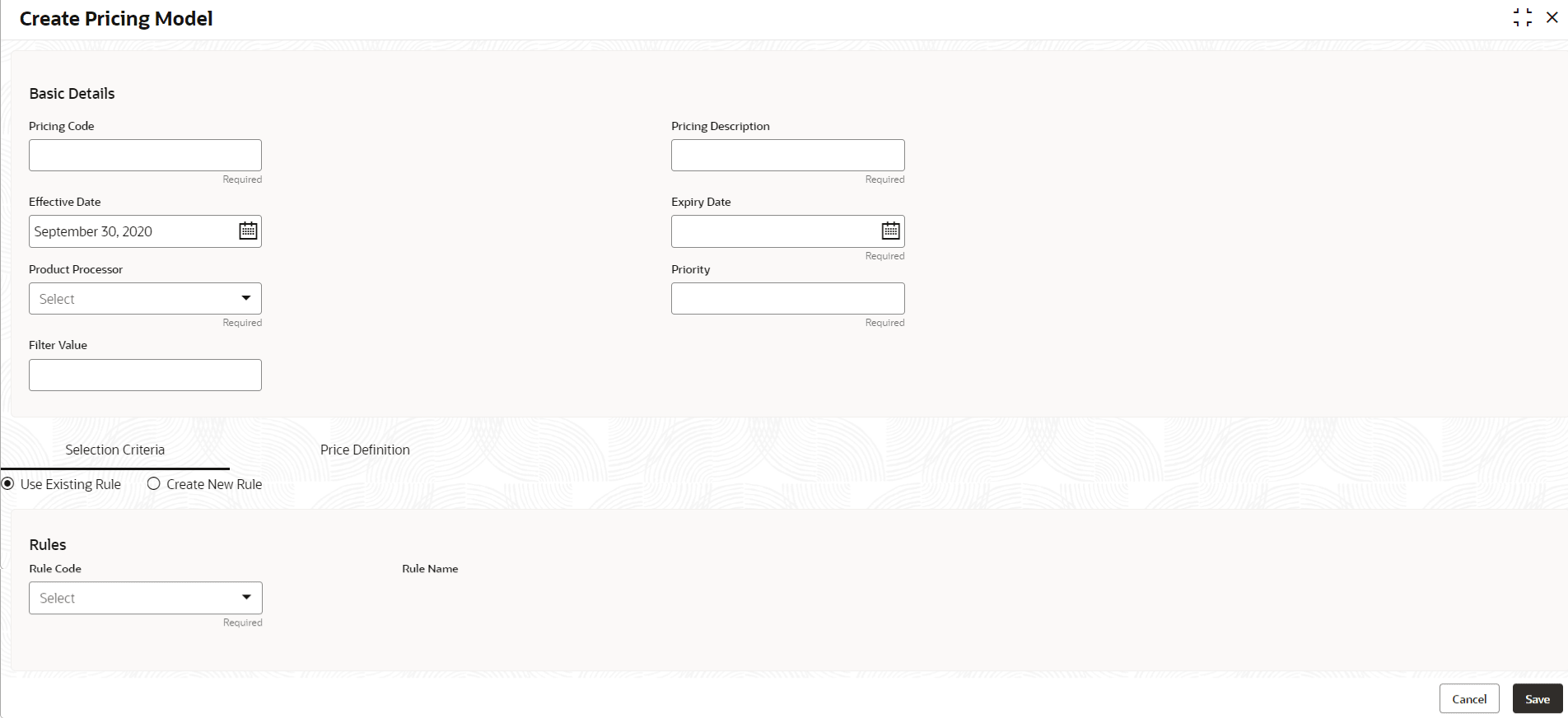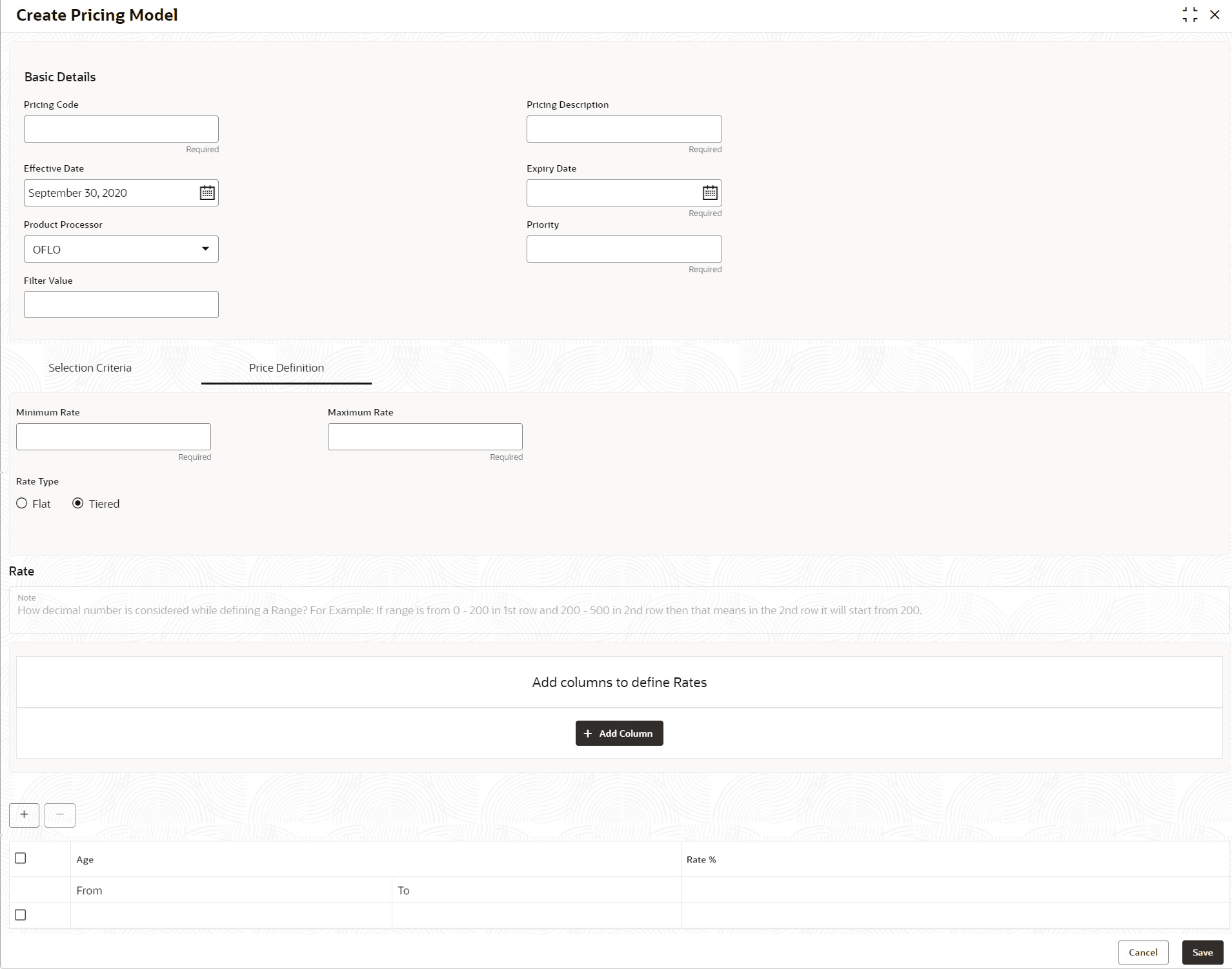- Oracle Banking Common Core User Guide
- Decision Service
- Pricing
- Create Pricing Model
3.12.1 Create Pricing Model
This topic describes the systematic instructions to create pricing model based on various pricing parameter by updating various details.
- On Homescreen, click Core Maintenance, under Core Maintenance, click Credit Decision.
- Under Credit Decision, click Maintenance, under Maintenance, click Pricing Model, under Pricing Model, click Create Pricing Model.The Create Pricing Model screen displays.
- On Create Pricing Model screen, specify the fields.For more information on fields, refer to the field description table.
Note:
The fields marked as Required are mandatory.Table 3-58 Create Pricing Model - Field Description
Field Description Pricing Code Specify the unique pricing code. Pricing Description Specify a short description for the pricing. Effective Date Specify the effective date. Expiry Date Specify the expiry date. Product Processor Specify the product processor for which the pricing is being created. Priority Specify the priority of the pricing. - Click the Selection Criteria to define pricing model.The Create Pricing Model - Selection Criteria screen displays.For more information on fields, refer to the field description table.
Figure 3-53 Create Pricing Model – Selection Criteria
Table 3-59 Create Pricing Model – Selection Criteria - Field Description
Field Description Use Existing Rule By default, this option is enabled. Indicates if the existing rule is linked. Rule Code Select the rule code from the drop-down list. 
Click this icon to get the information about the rule. Rule Name Displays the rule name of the rule code. Create New Rule Select this option to create new rule. Code Specify the rule code. Description Specify the rule description. + icon Click this icon to add new expression. Fact / Rules Select the fact or rule from the drop-down list. Once the user selects the fact/rules, one more field opens adjacent to the output, update the same based on the selected output option.
Operator Select the comparison operator from the drop-down list. The available options are:- <
- >
- +
- =
- %
- !=
- -
- >=
- <=
- *
- /
- Contains
- In
- Matches
- NotMatches
- NotContains
- Notin
Data Type Select the data type for the fact or rule. Once the user select the data type, one more field opens adjacent to the output, update the same based on the selected output option.
The available options are:- Text
- Number
- Boolean
- Date
- Fact
- Rules
The below option appears if the Data Type is selected as Boolean.- True
- False
Output Select the output from the drop-down list. Once the user select the data type, one more field opens adjacent to the output, update the same based on the selected output option.
The available options are:- Text
- Number
- Boolean
- Date
- Fact
- Rules
The below option appears if the Data Type is selected as Boolean.- True
- False
Expression Displays the expression updated in the expression builder. - Click Price Definition to define the pricing.
- Select the Rate Type options as Flat to specify the flat rate.The Create Pricing Model – Price Definition (Flat) screen displays.For more information on fields, refer to the field description table.
Figure 3-54 Create Pricing Model – Price Definition (Flat)
Table 3-60 Create Pricing Model – Price Definition (Flat) - Field Description
Field Description Minimum Rate Specify the minimum rate applicable for the defined pricing code. Maximum Rate Specify the maximum rate applicable for the defined pricing code. Rate Type Select the rate type from the drop-down list as Flat. Link a Rule? Select the option whether to link a rule to derive the price. The options are:- Yes
- No
Rate % Specify the interest rate application for the defined pricing. This field displays once you select the Rate Type option as Flatand Link a Rule? option as No.
Rule Select the rule for the defined pricing from the drop-down list. This field appears once you select the Rate Type option as Flat and Link a Rule? option as Yes.
- Select the Rate Type options as Tiered to link the list of features.
- Click Add Columns to select and link the features.The Add Features screen displays.
- Select the feature names from the list. (‘n’ number of features can be selected)
- Select the option whether to link a rule for defining the interest rate.
- Click Save to link the list of features for defining the tiered interest rate.The Create Pricing Model – Price Definition (Tiered) screen displays.For more information on fields, refer to the field description table.
Figure 3-56 Create Pricing Model – Price Definition (Tiered)
Table 3-61 Create Pricing Model – Price Definition (Tiered) - Field Description
Field Description Minimum Rate Specify the minimum rate applicable for the defined pricing code. Maximum Rate Specify the maximum rate applicable for the defined pricing code. Rate Type Select the rate type from the drop-down list as Tiered. <Numeric Feature> From Specify the minimum numeric value of feature to which the interest rate is applicable. <Numeric Feature> To Specify the maximum numeric value of feature to which the interest rate is applicable. <Character Feature> Value Specify the alphabetic value for which the interest rate is applicable. Rate % Specify the interest rate applicable for the defined tier. This field appears once you select the Rate Type option as Tiered and Link a Rule? option as No.
Rule Select the rule for the defined tier from the drop-down list. This field appears once you select the Rate Type option as Tiered and Link a Rule? option as Yes.
- Click Save to save the details.The Pricing Model is successfully created and can be viewed using View Pricing Model screen.
Parent topic: Pricing




